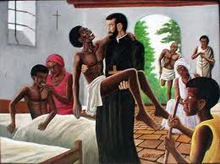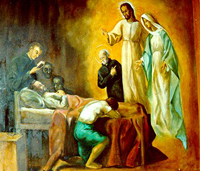


He was born in Verdú, Spain, on June 26, 1580.
He died in Cartagena, Colombia, on September 8, 1654.
__________________________________________________________
Peter Claver and Jane Corbero, Catalan farmers, had six children, but only John, the oldest survived, and the two youngest, Peter and Elizabeth. Their father could barely write his name, but he was a hard working man and a good Christian. Peter's childhood remained hidden to history like the lives of so many saints, even of Our Lord. It is known that he worked in the field with his family.
Peter graduated from the University of Barcelona. When he was 19 years old, he decided to become a Jesuit and entered in Tarragona. While he studied philosophy in Mallorca in 1605, he met St. Alphonsus Rodriguez, the porter of the school. The meeting was providential. St. Alphonsus received through a divine inspiration, knowledge of the future mission of the young Peter and from then on he did not stop encouraging him to go to evangelize the Spanish territories in America.
Peter believed in this inspiration and with great faith and the approval of his superiors he embarked for New Granada in 1610. He studied theology in Santa Fe de Bogota. He was there for two years, one in Tunja and then he was sent to Cartagena, which is today the coast of Colombia. In Caragena he was ordained a priest on March 20, 1616.
 Upon arriving in America, Peter encountered the terrible injustice of institutionalized slavery that had begun already from the Columbus' second trip on January 12, 1510, when the king ordered the use of blacks as slaves. It became a tragedy that involved nearly 14 million unhappy human beings. A million of them passed through Cartagena. The slaves came mostly from Guinea, from the Congo and Angola. The chiefs of some tribes of those lands sold their subjects and their prisoners. In America they were used for every type of forced work: agriculture, mining, and construction.
Upon arriving in America, Peter encountered the terrible injustice of institutionalized slavery that had begun already from the Columbus' second trip on January 12, 1510, when the king ordered the use of blacks as slaves. It became a tragedy that involved nearly 14 million unhappy human beings. A million of them passed through Cartagena. The slaves came mostly from Guinea, from the Congo and Angola. The chiefs of some tribes of those lands sold their subjects and their prisoners. In America they were used for every type of forced work: agriculture, mining, and construction.
Cartagena, being a strategic place on the route of the Spanish fleets, became a main center for the slave trade int he New World. A thousand slaves were unloaded each month. Even though half died at sea, the business was highly profitable. As such, the repeated censures of the Pope did nothing to stop this shameful human market.
Peter could not change the system, but there was much that he could do with the grace of God. But there was still a great lack of faith and love. Peter was up to the task. In the school of the great missionary, Fr. Alphonsus Sandoval, Peter wrote: "Ego Petrus Claver, etiopum semper servus" (I am Peter Claver, the slave of the negroes forever." And so it was. St. Peter did was not limited to just complaining about the injustices or lamenting about the times that he lived. He knew how to be holy in that situation and to let himself be completely used by Jesus Christ for his work of mercy. He became an apostle of the black slaves in Cartagena over forty years of intense missionary labor. Among so many comfortable Christians of the time, he knew how to be light and salt, he knew how to make known to history what is possible for God in a soul that has faith.
Despite his shyness which he had to overcome, he became an ingenious and courageous organizer. Each month when the arrival of a slave ship was announced, Fr. Claver went out to visit them and brought them food. The slaves were found tied in the lower part of the ship in inhumane conditions. They arrived in very bad conditions, victims of brutal treatment, malnutrition, of suffering and of fear. Claver attended to each one and cared for them with exquisite gentlness. And so he made them see that he was their defender and their father.
The slaves spoke different dialects and it was very difficult to communicate with them. To make headway through this difficulty, Fr. Claver organized a group of interpreters of different nationalities, he instructed them to be catechists.
While the slaves were held in Cartagena while waiting to be bought and taken to different places, Fr. Claver instructed them and baptized them. He met with them, concerned about their needs and defended them from their oppressors. This labor of love caused great trials for him. The slave traders were not his only enemies. The saint was accused of being indiscreet in his zeal for the slaves and of having profaned the Sacraments by giving them to creatures that hardly have a soul. The women of the upper class of Cartagena refused to enter the churches where Fr. Claver met with the slaves. His superiors often succumbed to the pressure to correct the excesses of Fr. Claver. Nevertheless, he could continue his work amid many humilliationsand obstacles. He would perform rigorous penances. He lacked the understanding and support of men but had a strength given by God.
Many, even those among them who were bothered by the charity of Father Claver, knew that he was doing a work of God, being a great prophet of evangelical love that knows neither bounds nor color. He was known in all of New Guinea for his miracles. He catechized and baptized more than 300,000 slaves.
On the morning of September 9, 1654, after having contemplated Jesus and the Blessed Virgin Mary, he went to heaven in great peace.
 He was beatified on July 16, 1850 by Pope Pius IX.
He was beatified on July 16, 1850 by Pope Pius IX.
He was canonized January 15, 1888 by Leo XIII together with Alfonso Rodriguez.
On July 7, 1896 he was proclaimed the particular patron of all catholic missions among African peoples.
El 7 de Julio de 1896 fue proclamado patrón especial de todas las misiones católicas entre los negros.
Pope John Paul II prayed before the mortal remains of Saint Peter Clave in the Jesuit Church in Cartegena on July 6, 1986.

